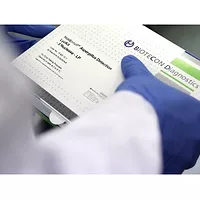Real-Time PCR Test Kit Provides Faster Time to Results
Salmonella is a bacterium that causes one of the most common enteric (intestinal) infections in the United States— salmonellosis. In some states, salmonellosis is the most commonly reported cause of enteric disease, and overall it is the second most common bacterial foodborne illness reported (usually slightly less frequent than Campylobacter infection). The reported incidence of Salmonella illnesses is about 14 cases per each 100,000 persons, amounting to approximately 30,000 confirmed cases of salmonellosis yearly in the U.S. according to the CDC in 2005. In this year alone, just over 36,000 cases were reported from public health laboratories across the nation, representing a 12% decrease compared with the previous decade, but a 1.5 percent increase over 2004 according to the CDC last year. As only about 3 percent of Salmonella cases are officially reported nationwide, and many milder cases are never diagnosed, the true incidence is undoubtedly much higher. The CDC estimates that 1.4 million cases occur annually.
Cargill Chocolate Products, a producer of chocolate for the chocolate industry, sought to implement an ISO method for the detection of Salmonella in their finished products as well as raw materials, including cocoa liquor, cocoa butter, milk powders (whole and skim milk, lactose and whey powder) and emulsifiers. The company’s products range from plain, milk and white chocolate for liquid delivery to solid products in block-form, buttons, sprinkles, drops, organic chocolate, vegetable fat-based fillings, yoghurt compounds and fillings. Cargill is one of the world’s major originators and processors of cocoa beans, manufacturing cocoa products as well as industrial chocolate, which are used by food and confectionery companies to produce cakes, biscuits, confectionery and other products for consumers around the world.
With 400 employees at six European production facilities, it is imperative for Cargill Chocolate Products to maintain a strict control safety regimen for detection of microbial pathogens. As Salmonella is such a major problem for food processors and manufacturers, they needed to have the most robust testing method available for their raw materials and finished products.
A Search for a Better Method
Previously, the company was using a Salmonella-derivative method that allowed for the generation of results in 48 hours, including a pre-enrichment in milk for 20 hours, doubling of cell numbers for 8 hours in Rappaport-Vassiliadis media and incubation on XLD and Hektoen plates for 20 hours. An additional 24 hours was then needed for the confirmation of suspicious colonies with a rapid biochemical identification kit.
Although their microbial laboratories were accredited according to ISO17025 and the Salmonella ring tests were extremely reliable, there was a general discomfort among some of their customers as the test used was not an approved ISO method.
PCR technology has allowed a tremendous increase in detection sensitivity and, therefore, a PCR-based test was investigated. As luck would have it, cocoa molecules can inhibit PCR and, once again, the company had to embark on a search for possible solutions to the problem of Salmonella testing in chocolate-based products.
A collaboration between Cargill and Bio-Rad Laboratories solved the problem. The use of the iQ-Check™ Salmonella I kit from Bio-Rad succeeded for most of the matrixes. Although the use of cocoa powder inhibited the PCR, the new generation Bio-Rad kit, together with the expertise and experience of Cargill Chocolate Products, was able to overcome this additional challenge. Today, no interference from either cocoa liquor or cocoa powder matrix is noticed in the testing for Salmonella.
This real-time PCR kit allows rapid control and reaction times in HACCP procedures. Using gene-specific probes and primers enhances reproducibility while increasing sensitivity and specificity and PCR internal controls ensure accurate results. As a high-throughput methodology, 94 samples can be processed simultaneously, and the test can be performed in parallel with other iQ-Check tests on the 96-well real-time instrument (tests are available for E. coli O157:H7, Listeria spp. and Listeria monocytogenes). Bio-Rad also offers a smaller 48-well real-time instrument, for laboratories with lower throughput. Ready-made reagents allow for simple extraction, amplification and detection. As a result of these advantages, tested products can be released more quickly, saving storage costs for the company. The test ensures reliable results in less than 24 hours, one-third the time of Cargill’s former method.
Redouan Sadiky, in charge of all Cargill Chocolate Products European laboratories, states, "The Cargill method is very easy for a technician to learn and provides us quicker results compared with our old method. Raw material is released one day quicker, resulting in a lower raw material stock need and cost savings. Our customers are more confident with the PCR-based method compared with our internal method."
After the success of the iQ-Check™ Salmonella II kit in the French factory, Cargill Chocolate decided to implement the Bio-Rad test and corresponding equipment in each of the other chocolate factories (in Belgium, the UK, and Germany) to perform Salmonella testing in both raw materials and finished products.
Looking for quick answers on food safety topics?
Try Ask FSM, our new smart AI search tool.
Ask FSM →







